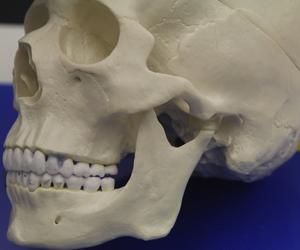FSU, Clemson researchers working together to prevent joint disorders

Model of temporomandibular joint (photo by Medical University of South Carolina Public Relations)
Florida State University and Clemson University may be competing on the football field this weekend, but researchers from the two institutions are working together off the field to diagnose and prevent widespread joint disorders.
Elizabeth Slate, the Duncan McLean and Pearl Levine Fairweather Professor in Florida State’s Department of Statistics, is collaborating with Hai Yao, an associate professor of bioengineering at Clemson and of craniofacial biology at the Medical University of South Carolina, to advance the early diagnosis of human joint degeneration, specifically in the temporomandibular joint (TMJ), and develop a measuring system to understand the relationship between jaw loading, nutrient concentration profiles and metabolic rates in the joint. (Jaw loading is subjecting the joint to force, such as when chewing or clenching. The nutrient concentration profile is the pattern of nutrients in the TMJ across the disc or over time. The metabolic rate is the speed at which energy is used, crudely the rate of consumption of the nutrients.)

Elizabeth Slate

Hai Yao
Approximately 35 million Americans suffer from TMJ disorders, causing pain in and around the jaw joint and nearby muscles and affecting their ability to eat, chew, swallow, make facial expressions and breathe. Health care costs for the disorders total as much as $4 billion, according to the National Institute of Dental and Craniofacial Research.
“Today, there is not a method for early detection of TMJ degeneration,” Slate said. “We are developing a novel, integrated and dynamic measuring system to determine patient-specific bio-indicators for early diagnosis of TMJ degeneration.”
“In contrast to other joints, attempts to surgically reconstruct the TMJ have resulted in severe disabilities,” said Yao, principal investigator for the project funded by the National Institutes of Health. “Thus, early diagnosis and management are critical.”
The researchers suspect that by understanding the impact of mechanical loading, they will establish a foundation to explain the biomechanical etiology of TMJ disorders, which will lead to identifying potential metabolic bio-indicators of early TMJ degeneration.
Using an innovative and multiscale approach, the researchers are integrating joint imaging and kinematics, cartilage tissue mechanics and cell metabolism, which will produce data that characterize the effect of dynamic contact mechanics on cell behavior as a contributing factor to the fatigue failure of tissues.
“Such data has never before been collected from living humans,” Yao said.
The outcomes of this project will closely address the current clinical barriers for treating TMJ disorders will lead to an applicable clinical diagnostic tool for early TMJ degeneration.

